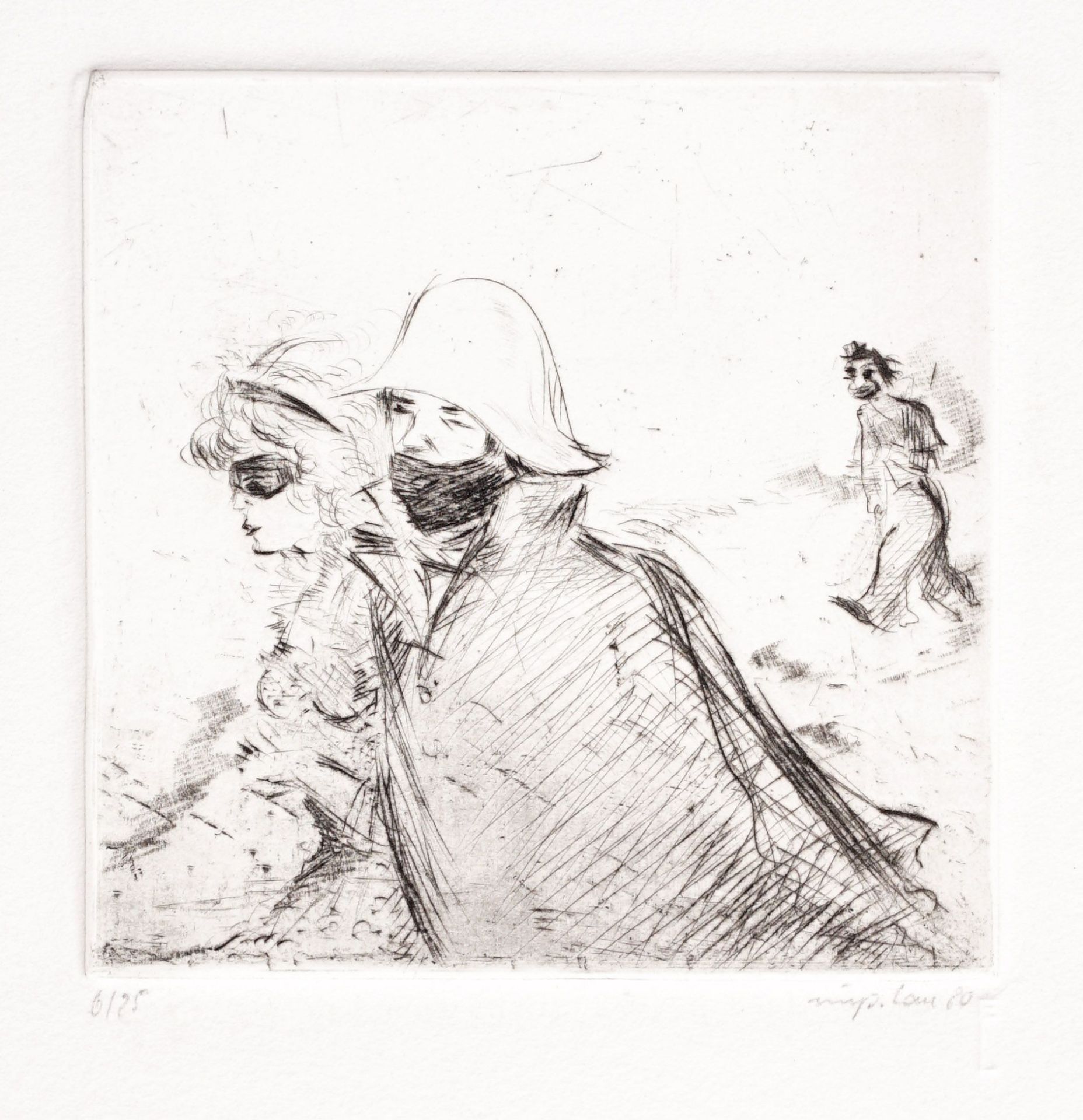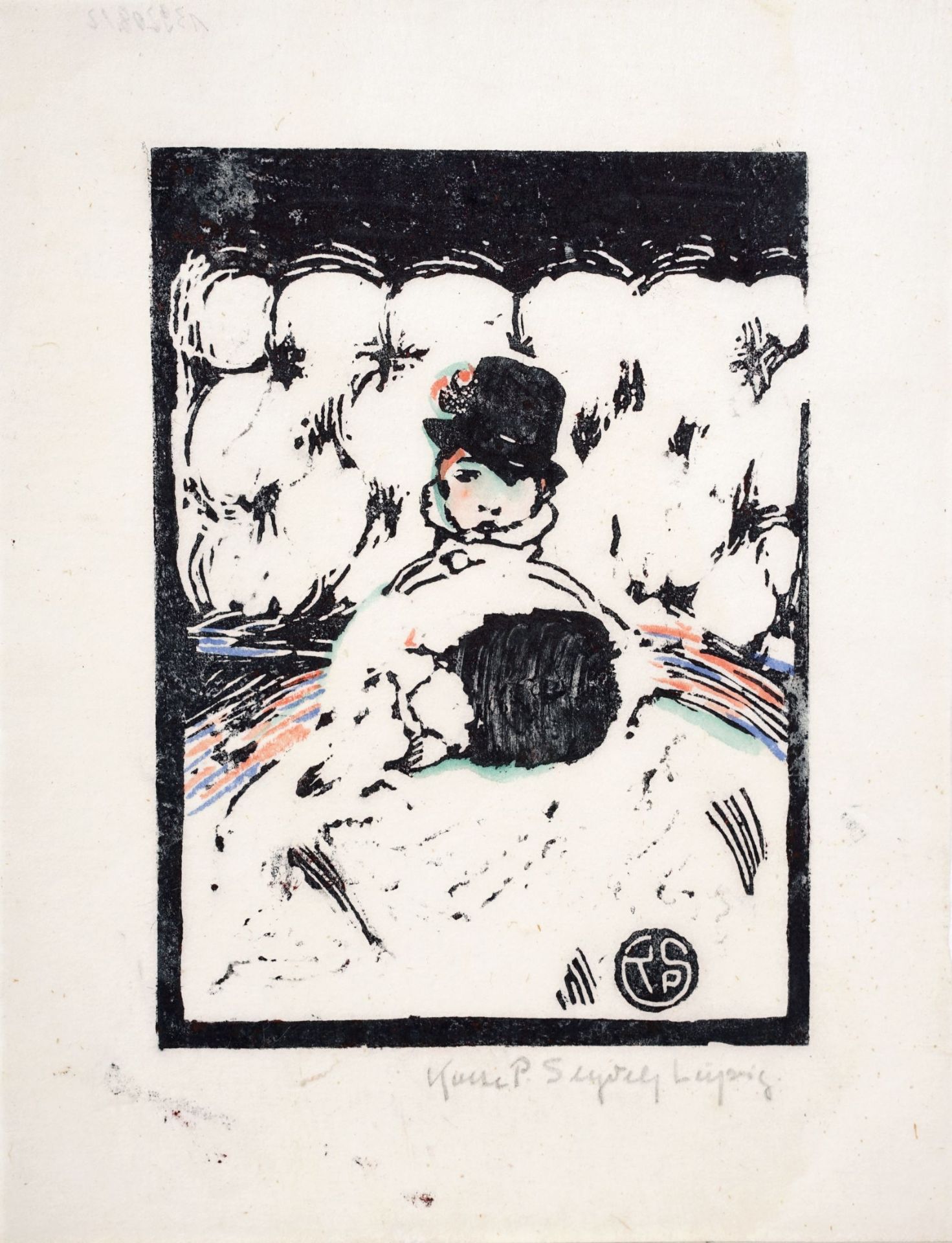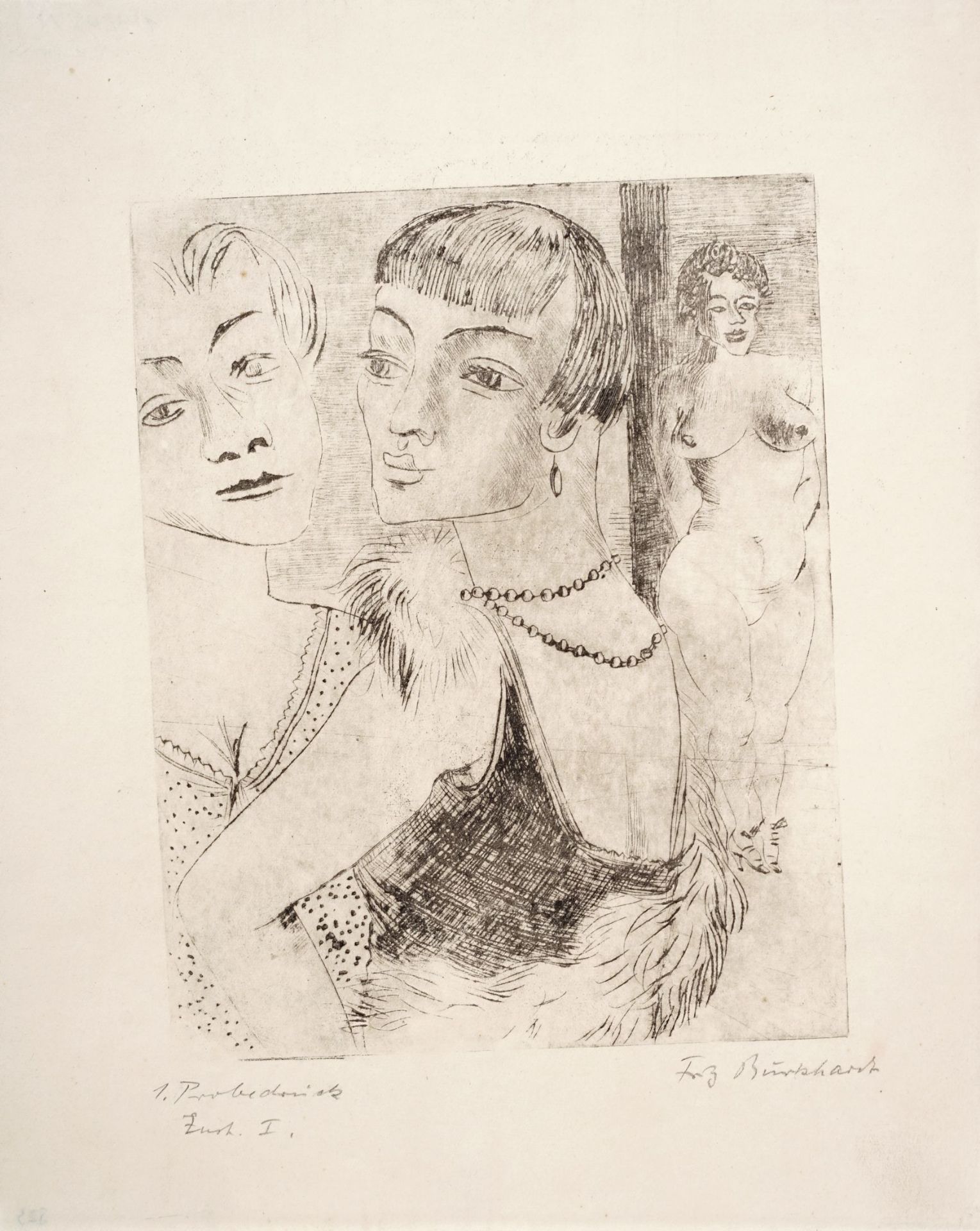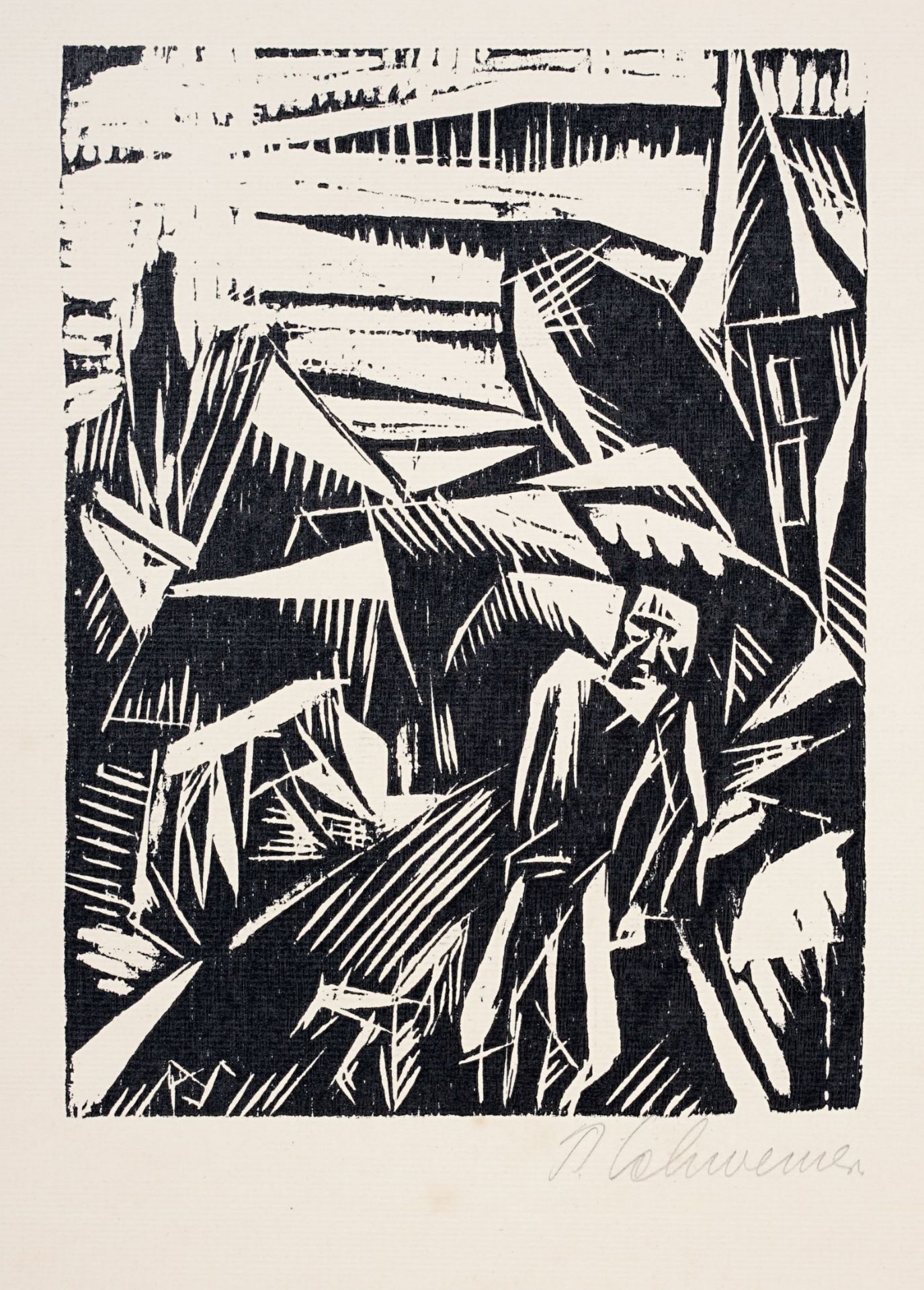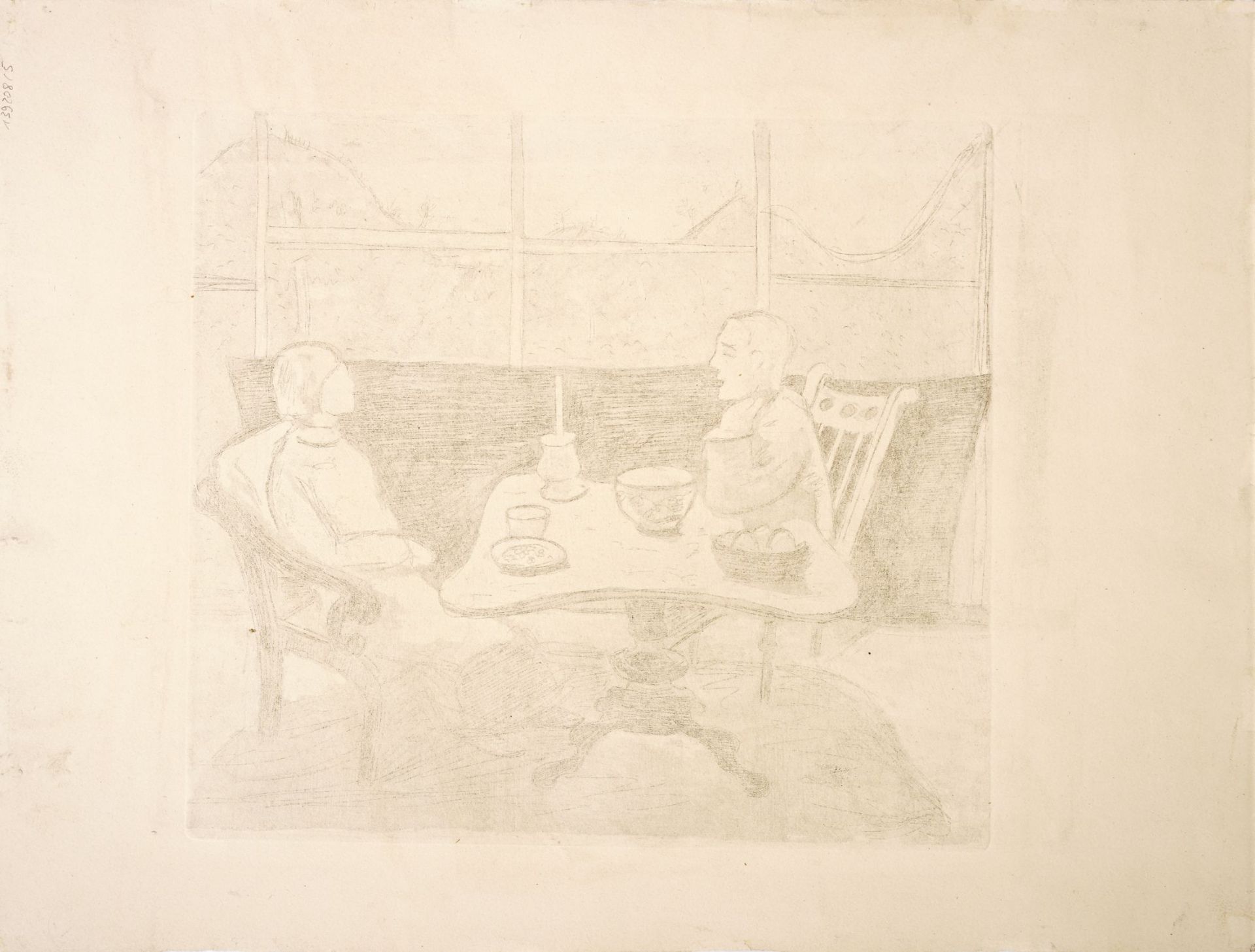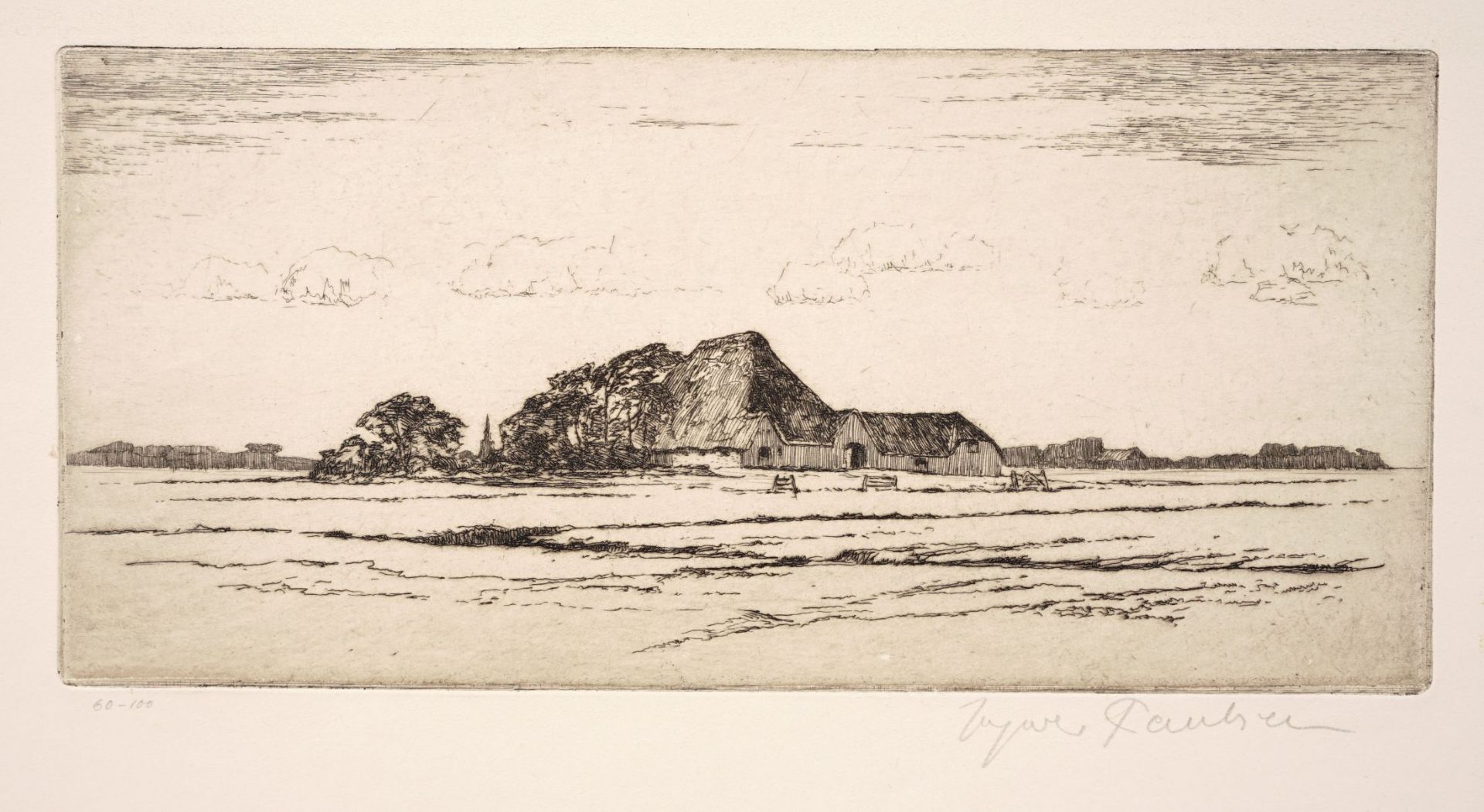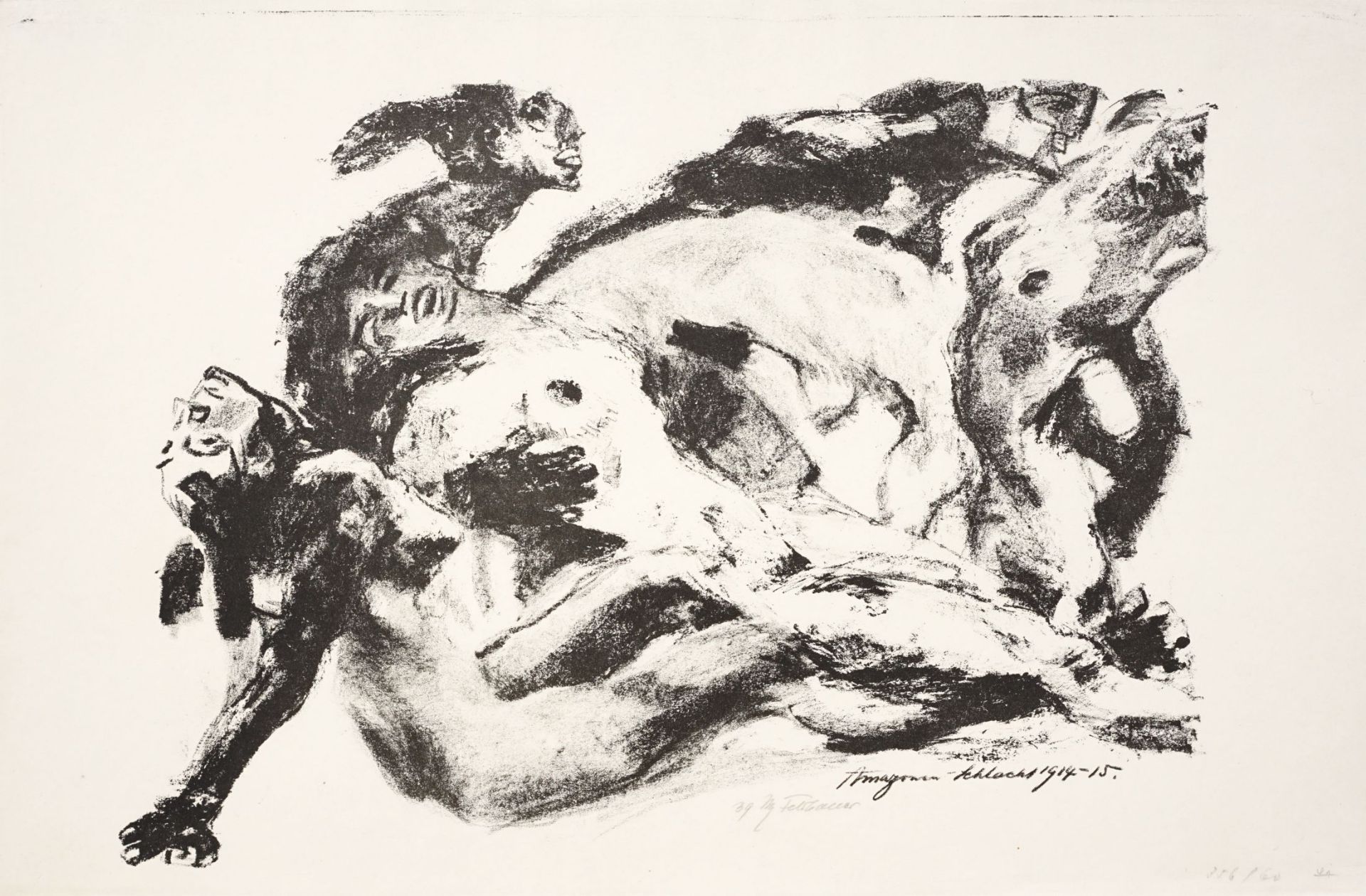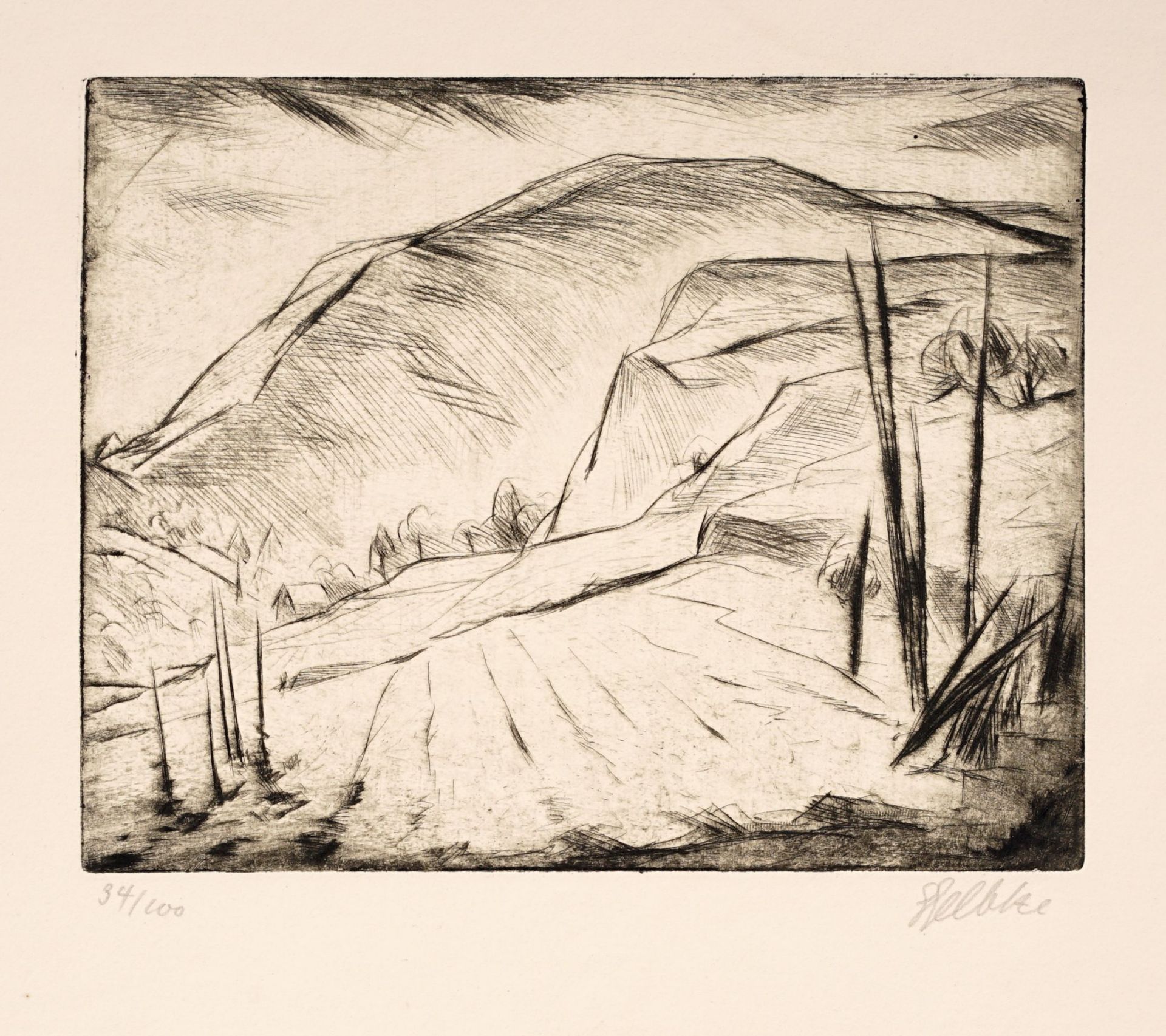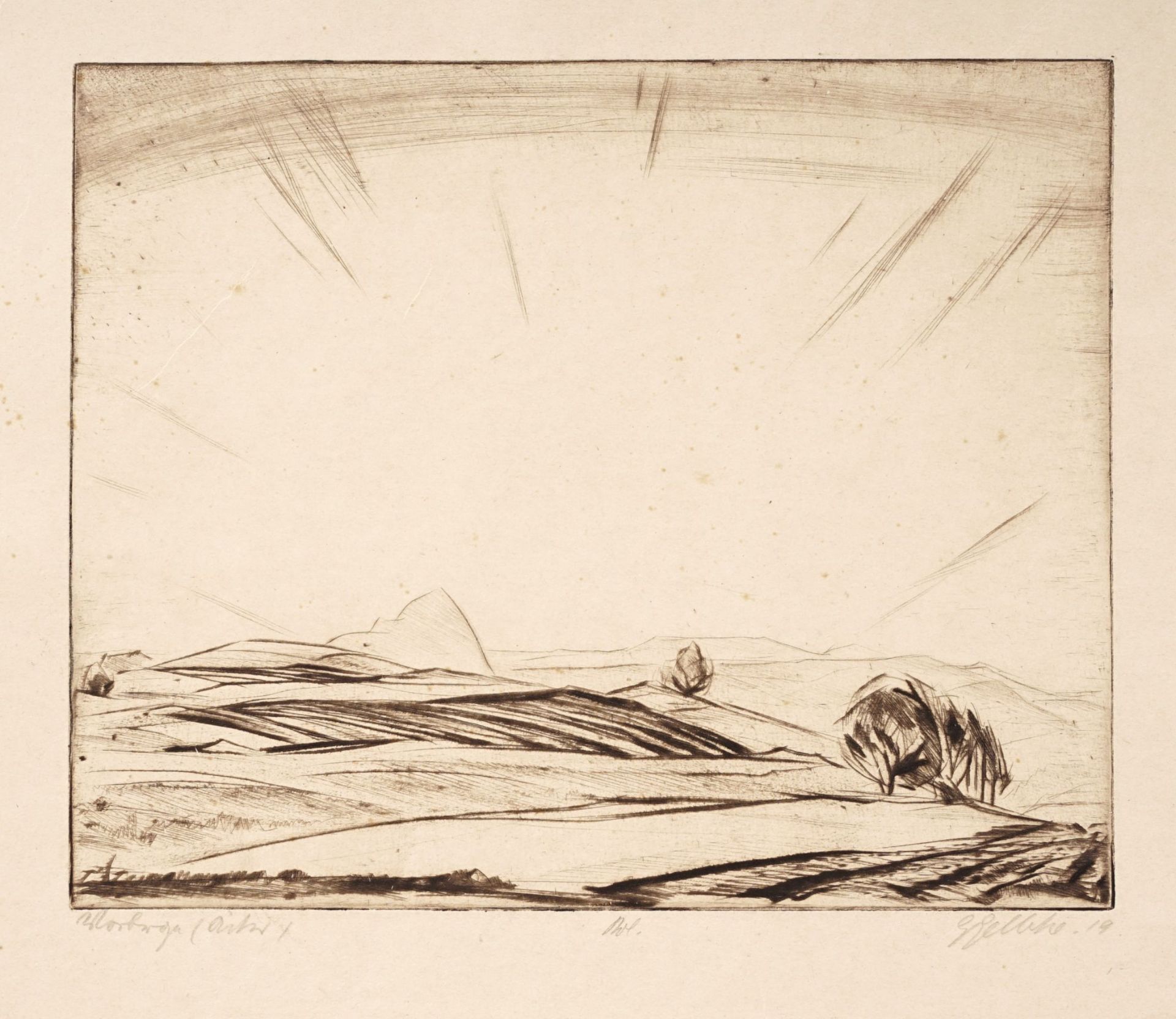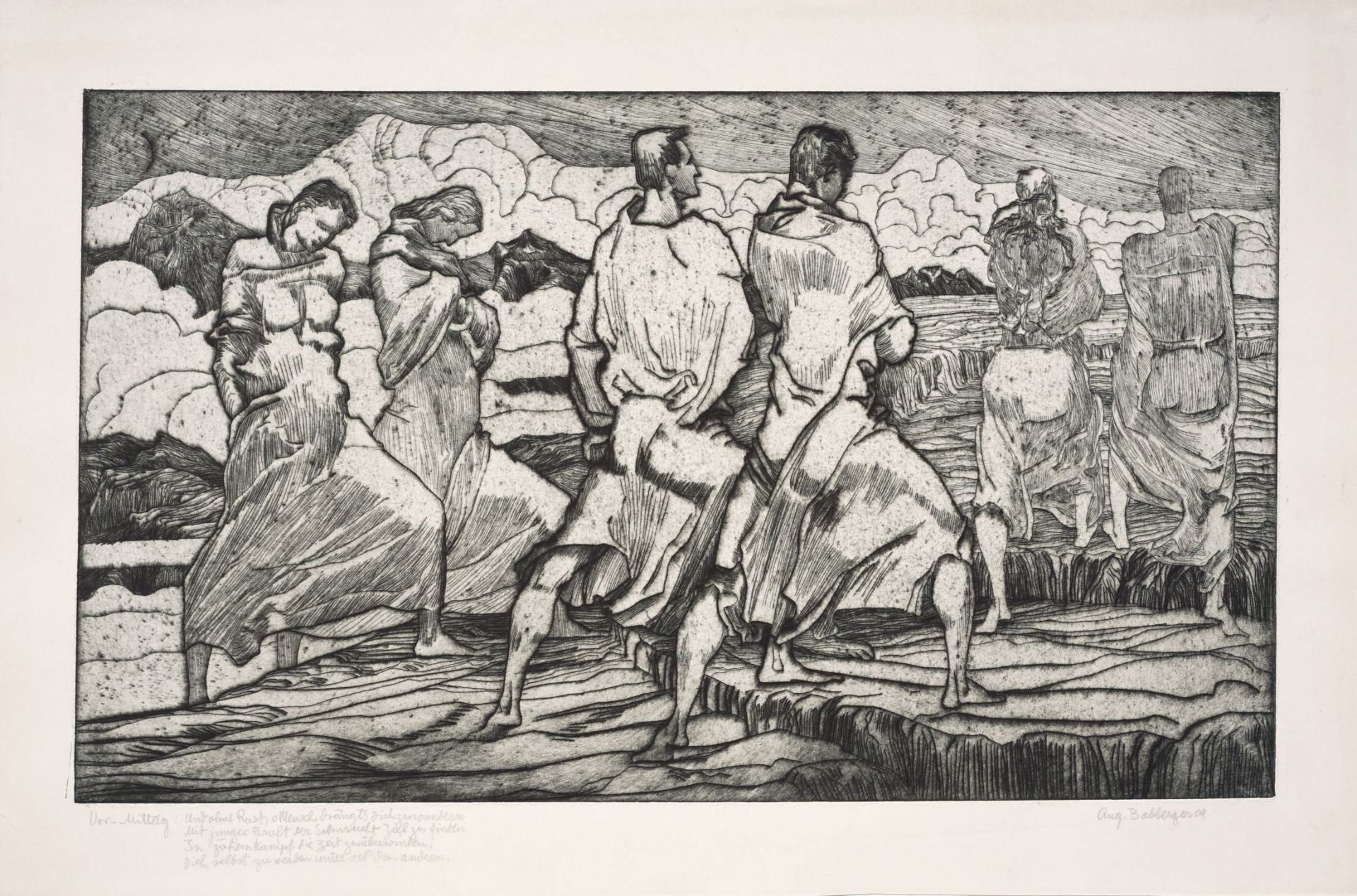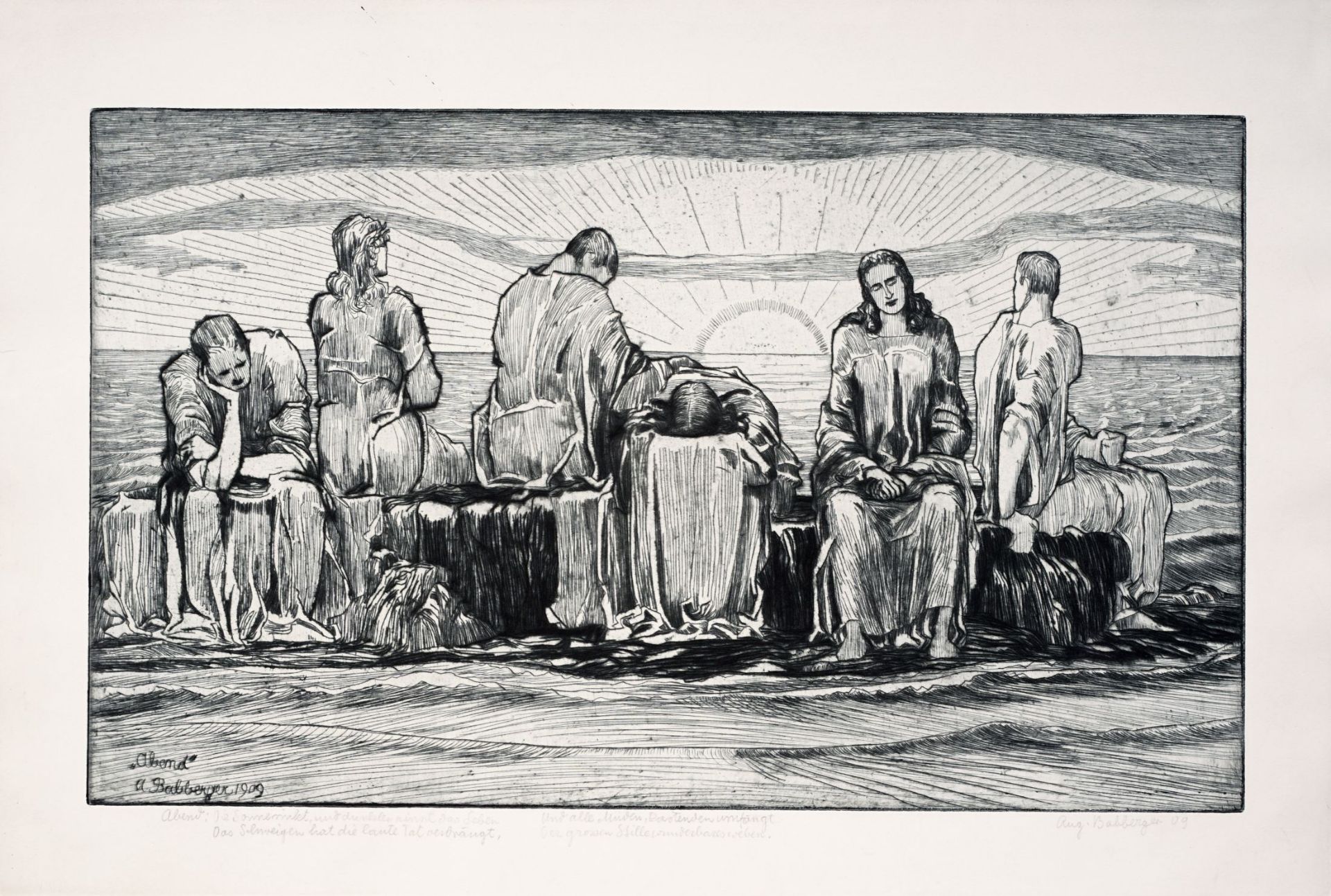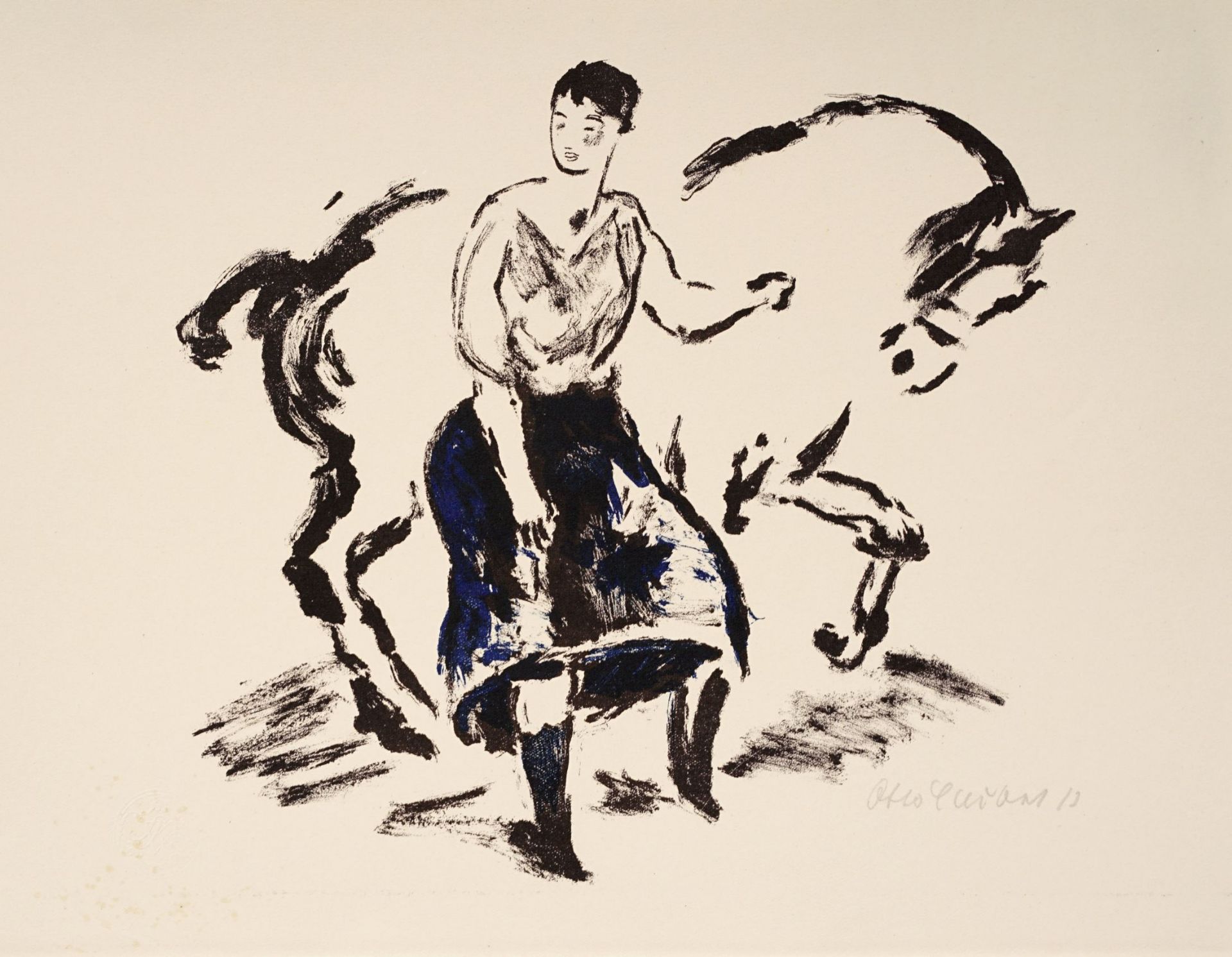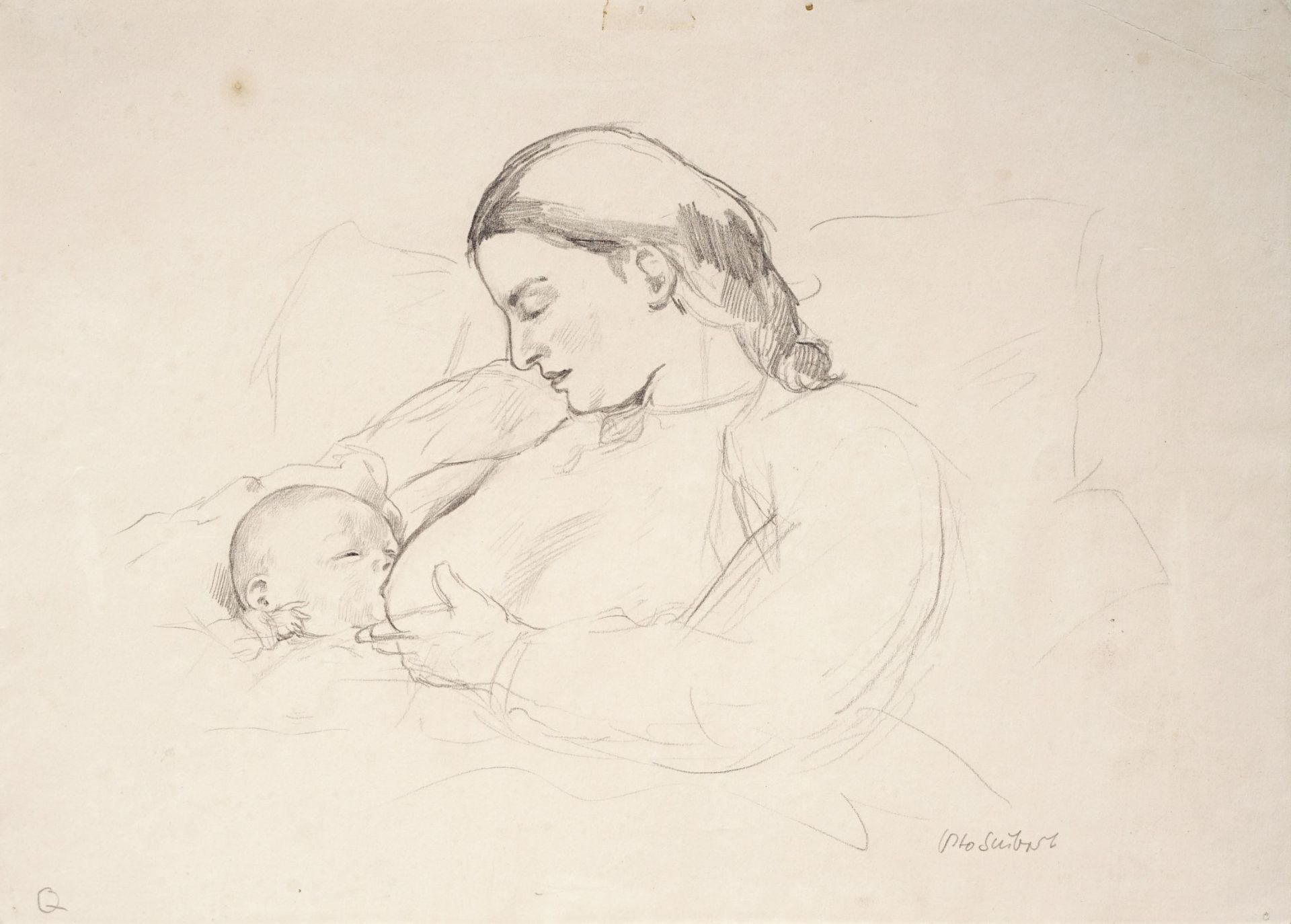386
Verschiedene Künstler, 14 Druckgrafiken und eine Zeichnung. 1910er-1930er Jahre.
August Babberger 1885 Hausen im Wiesental – 1936 Altdorf/Schweiz
Fritz Burkhardt 1900 Arnstein/ Franken – 1983 München
Max Feldbauer 1869 Neumarkt/Oberpfalz – 1948 München
Georg Gelbke 1882 Rochlitz – 1947 Dresden
Hans Meyboden 1901 Verden – 1965 Freiburg i. Br.
Ingwer Paulsen 1883 Ellerbeck b. Kiel – 1943 Halebüll
Otto Schubert 1892 Dresden – 1970 ebenda
Paul Schwemer 1889 Neubukow – 1938 Hamburg
Max Schwimmer 1895 Leipzig – 1960 ebenda
Kaete P. Seydel ? – lebte um 1900 in Leipzig
Jeweils in Blei signiert, teilweise datiert und nummeriert.
Mit den Arbeiten:
a) Max Schwimmer "Masken im Schnee". 1927. Kaltnadelradierung. Unsigniert, posthumer Abzug von 1980. WVZ George 27.
b) Kaete P. Seydel, Dame mit Hut. Farbholzschnitt.
c) Fritz Burkhardt, Drei Damen. Radierung.
d) Paul Schwemer "Mann in Landschaft", 1923, Holzschnitt, aus "Das neue Hamburg", einem von 50 signierten Exemplaren. Gedruckt bei der "Druckerei-Gesellschaft Hartung & Co". Söhn HDO 273–3.
e) Hans Meyboden, Auf der Straße, 1924. Aquatintaradierung.
f) Ingwer Paulsen, Norddeutsches Gehöft. Radierung.
g & h) Max Feldbauer, Exstase / Pferde. Lithografien, eine Arbeit datiert "1939".
i & j) Georg Gelbke, Zwei Landschaftsdarstellungen. Radierungen in Schwarzbraun. Eine Arbeit datiert "1919".
k & l) August Babberger, Figuren in einer Landschaft / Am Meer. 1909. Zwei Radierungen.
m) & n) Otto Schubert, Frau und Pferd / Bootsausflug. Farblithografien. Eine Arbeit datiert "1913".
o) Otto Schubert, Stillende Mutter. Bleistiftzeichnung.
Vereinzelt leicht knickspurig, angeschmutzt und mit kl. Flecken. Teilweise lichtrandig. Blattränder partiell gestaucht. Einige Blätter verso mit Spuren früherer Montierung.
Maße: Med. min. Pl. 9,8 x 10 cm, Med. max. St. 63,5 x 52 cm, Bl. max. 57 x 75,3 cm.
August Babberger
1885 Hausen im Wiesental – 1936 Altdorf/Schweiz
Sohn eines Zimmermanns. Ab 1895 wuchs er in Basel auf. Vor seinem Versuch in der Kunstakademie München aufgenommen zu werden, erhielt er Unterricht bei einem Malermeister. Ab 1908 konnte er auf Empfehlung Hans Thoma an der Akademie in Karlsruhe studieren. Im folgenden Jahr erhielt er ein Stipendium für die Radierklasse an der Internationalen Kunstschule in Florenz. Ab 1915 hielt er sich überwiegend in der Schweiz auf. 1919 war er Gründungsmitglied der Darmstädter Sezession. 1920 wurde er zum Professor für Dekorative Malerei an die Akademie in Karlsruhe berufen. 1923–30 war er ebenda Direktor. 1933 wurde er als "entarteter Künstler" diffamiert und seines Lehramtes enthoben.
Max Feldbauer
1869 Neumarkt/Oberpfalz – 1948 München
Besuch der Münchner Kunstgewerbeschule, der privaten Malschule Simon Hollósys und der Münchner Akademie bei Otto Seitz, Paul Hoecker und Johann Caspar Herterich. 1899 Mitbegründer der Künstlergruppe "Die Scholle" sowie Mitwirkung an der Wochenzeitschrift "Die Jugend". 1913 Mitbegründer und Vorstand der Münchener Neuen Secession. 1899 Heirat mit der Malerin Elise Eigner. 1901–15 Dozent an der Damenakademie des Münchner Künstlerinnenvereins. 1912–22 Leitung einer Malschule bei Dachau. Reisen in die Bretagne, in die Schweiz, nach Tirol, Helgoland und Italien. Ab 1916 Berufung als Dozent an die Dresdner Kunstgewerbeschule, 1918 Berufung an die Dresdner Kunstakademie, dort ab 1928 Präsident. 1933 Ausstellungsverbot, daraufhin Umzug nach München, dort 1944 ausgebombt.
Georg Gelbke
1882 Rochlitz – 1947 Dresden
1901–07 Studium an der Dresdner Akademie bei Richard Müller, Oskar Zwintscher und Gotthardt Kuehl sowie an der Münchener Kunstakademie. 1911 gemeinsame Ausstellung mit Paul Wilhelm im Kunstsalon Emil Richter Dresden. 1918 Heirat mit Coelestine Arndt. 1950 Gedächtnisausstellung in den Staatl. Kunstsammlungen Dresden. 1992 Ausstellung im Leonhardi-Museum Dresden.
Hans Meyboden
1901 Verden – 1965 Freiburg i. Br.
Kopiert schon in jungen Jahren Werke der Kunsthalle Bremen. Begegnung mit Oskar Kokoschka. 1923–25 Aufenthalte in den USA, im Harz und wiederholt auf den Nordseeinseln. 1925–35 in Berlin ansässig. Erhält durch die Nationalsozialisten Ausstellungsverbot. Geht 1935 mit einem Freund nach Fischerhude bei Bremen, lebt dort in völliger Zurückgezogenheit. 1944–46 als Tuberkulosekranker in Davos. Wird 1956 an die Karlsruher Akademie berufen.
Ingwer Paulsen
1883 Ellerbeck b. Kiel – 1943 Halebüll
Studium an der Münchner Akademie bei P. Halm und H. Olde. 1908–10 Aufenthalt in Paris. Studienreisen in die Benelux-Staaten und nach Italien. Er lebte um 1913 in Weimar. 1918 ließ er sich schließlich in Friesland nieder. Neben den Motiven seiner norddeutschen Heimat prägten vor allem die Eindrücke der Italienreise während des Studiums seine Arbeiten.
Otto Schubert
1892 Dresden – 1970 ebenda
1906–09 Studium an der Kunstgewerbeschule Dresden. Bis 1913 Bühnenmaler am Hoftheater, 1913/14 Studium an der Kunstakademie Dresden bei Emanuel Hegenbarth. 1917 einjähriges Studium an der Dresdner Kunstakademie bei Otto Gussmann. 1919–32 Mitglied der Dresdner Sezession. 1945 Vernichtung eines großen Teils des Werkes bei der Zerstörung Dresdens. 1957 Ausstellung im Kupferstichkabinett der Staatl. Museen in Berlin.
Paul Schwemer
1889 Neubukow – 1938 Hamburg
1904–09 Lehrerseminar in Hamburg. 1911–13 Zeichenlehrerseminar an der dortigen Kunstgewerbeschule bei Arthur Illies. 1914 Teilnahme an der Gruppenausstellung im Hamburger Kunstverein. 1919 Gründung der avantgardistischen Zeitschrift "Die rote Erde" mit dem Maler und Schriftsteller Karl Lorenz. 1920 Beitritt zur Hamburgischen Künstlerschaft. 1937 wurden im Zuge der nationalsozialisitischen Ausstellung "Entartete Kunst" sechs Bilder Schwemmers aus der Hamburger Kunsthalle beschlagnahmt und vernichtet.
Max Schwimmer
1895 Leipzig – 1960 ebenda
1910–15 Ausbildung im Lehrerseminar Leipzig-Connewitz. 1916–19 Hilfslehrer u. Vikar in Marienberg. 1920–23 Studium der Philosophie u. Kunstgeschichte an der Universität Leipzig. 1924 Teilnehmer der Sommerkurse von Hans Purrmann auf Ischia. 1926 Lehrer an der Leipziger Kunstgewerbeschule. 1933 Entlassung aus dem Lehramt bei Machtantritt der Nazis, zeitweiliges Ausstellungsverbot. 1946 Direktor der Leipziger Kunstgewerbeschule, Berufung als Professor an die Staatl. Akademie für Graphische Künste und Buchgewerbe Leipzig. 1951 an die Kunstakademie Dresden berufen (bis 1960). Mit Werken in zahlreichen nationalen u. internationalen Sammlungen vertreten.
August Babberger 1885 Hausen im Wiesental – 1936 Altdorf/Schweiz
Fritz Burkhardt 1900 Arnstein/ Franken – 1983 München
Max Feldbauer 1869 Neumarkt/Oberpfalz – 1948 München
Georg Gelbke 1882 Rochlitz – 1947 Dresden
Hans Meyboden 1901 Verden – 1965 Freiburg i. Br.
Ingwer Paulsen 1883 Ellerbeck b. Kiel – 1943 Halebüll
Otto Schubert 1892 Dresden – 1970 ebenda
Paul Schwemer 1889 Neubukow – 1938 Hamburg
Max Schwimmer 1895 Leipzig – 1960 ebenda
Kaete P. Seydel ? – lebte um 1900 in Leipzig
Jeweils in Blei signiert, teilweise datiert und nummeriert.
Mit den Arbeiten:
a) Max Schwimmer "Masken im Schnee". 1927. Kaltnadelradierung. Unsigniert, posthumer Abzug von 1980. WVZ George 27.
b) Kaete P. Seydel, Dame mit Hut. Farbholzschnitt.
c) Fritz Burkhardt, Drei Damen. Radierung.
d) Paul Schwemer "Mann in Landschaft", 1923, Holzschnitt, aus "Das neue Hamburg", einem von 50 signierten Exemplaren. Gedruckt bei der "Druckerei-Gesellschaft Hartung & Co". Söhn HDO 273–3.
e) Hans Meyboden, Auf der Straße, 1924. Aquatintaradierung.
f) Ingwer Paulsen, Norddeutsches Gehöft. Radierung.
g & h) Max Feldbauer, Exstase / Pferde. Lithografien, eine Arbeit datiert "1939".
i & j) Georg Gelbke, Zwei Landschaftsdarstellungen. Radierungen in Schwarzbraun. Eine Arbeit datiert "1919".
k & l) August Babberger, Figuren in einer Landschaft / Am Meer. 1909. Zwei Radierungen.
m) & n) Otto Schubert, Frau und Pferd / Bootsausflug. Farblithografien. Eine Arbeit datiert "1913".
o) Otto Schubert, Stillende Mutter. Bleistiftzeichnung.
Vereinzelt leicht knickspurig, angeschmutzt und mit kl. Flecken. Teilweise lichtrandig. Blattränder partiell gestaucht. Einige Blätter verso mit Spuren früherer Montierung.
Maße: Med. min. Pl. 9,8 x 10 cm, Med. max. St. 63,5 x 52 cm, Bl. max. 57 x 75,3 cm.
August Babberger
1885 Hausen im Wiesental – 1936 Altdorf/Schweiz
Sohn eines Zimmermanns. Ab 1895 wuchs er in Basel auf. Vor seinem Versuch in der Kunstakademie München aufgenommen zu werden, erhielt er Unterricht bei einem Malermeister. Ab 1908 konnte er auf Empfehlung Hans Thoma an der Akademie in Karlsruhe studieren. Im folgenden Jahr erhielt er ein Stipendium für die Radierklasse an der Internationalen Kunstschule in Florenz. Ab 1915 hielt er sich überwiegend in der Schweiz auf. 1919 war er Gründungsmitglied der Darmstädter Sezession. 1920 wurde er zum Professor für Dekorative Malerei an die Akademie in Karlsruhe berufen. 1923–30 war er ebenda Direktor. 1933 wurde er als "entarteter Künstler" diffamiert und seines Lehramtes enthoben.
Max Feldbauer
1869 Neumarkt/Oberpfalz – 1948 München
Besuch der Münchner Kunstgewerbeschule, der privaten Malschule Simon Hollósys und der Münchner Akademie bei Otto Seitz, Paul Hoecker und Johann Caspar Herterich. 1899 Mitbegründer der Künstlergruppe "Die Scholle" sowie Mitwirkung an der Wochenzeitschrift "Die Jugend". 1913 Mitbegründer und Vorstand der Münchener Neuen Secession. 1899 Heirat mit der Malerin Elise Eigner. 1901–15 Dozent an der Damenakademie des Münchner Künstlerinnenvereins. 1912–22 Leitung einer Malschule bei Dachau. Reisen in die Bretagne, in die Schweiz, nach Tirol, Helgoland und Italien. Ab 1916 Berufung als Dozent an die Dresdner Kunstgewerbeschule, 1918 Berufung an die Dresdner Kunstakademie, dort ab 1928 Präsident. 1933 Ausstellungsverbot, daraufhin Umzug nach München, dort 1944 ausgebombt.
Georg Gelbke
1882 Rochlitz – 1947 Dresden
1901–07 Studium an der Dresdner Akademie bei Richard Müller, Oskar Zwintscher und Gotthardt Kuehl sowie an der Münchener Kunstakademie. 1911 gemeinsame Ausstellung mit Paul Wilhelm im Kunstsalon Emil Richter Dresden. 1918 Heirat mit Coelestine Arndt. 1950 Gedächtnisausstellung in den Staatl. Kunstsammlungen Dresden. 1992 Ausstellung im Leonhardi-Museum Dresden.
Hans Meyboden
1901 Verden – 1965 Freiburg i. Br.
Kopiert schon in jungen Jahren Werke der Kunsthalle Bremen. Begegnung mit Oskar Kokoschka. 1923–25 Aufenthalte in den USA, im Harz und wiederholt auf den Nordseeinseln. 1925–35 in Berlin ansässig. Erhält durch die Nationalsozialisten Ausstellungsverbot. Geht 1935 mit einem Freund nach Fischerhude bei Bremen, lebt dort in völliger Zurückgezogenheit. 1944–46 als Tuberkulosekranker in Davos. Wird 1956 an die Karlsruher Akademie berufen.
Ingwer Paulsen
1883 Ellerbeck b. Kiel – 1943 Halebüll
Studium an der Münchner Akademie bei P. Halm und H. Olde. 1908–10 Aufenthalt in Paris. Studienreisen in die Benelux-Staaten und nach Italien. Er lebte um 1913 in Weimar. 1918 ließ er sich schließlich in Friesland nieder. Neben den Motiven seiner norddeutschen Heimat prägten vor allem die Eindrücke der Italienreise während des Studiums seine Arbeiten.
Otto Schubert
1892 Dresden – 1970 ebenda
1906–09 Studium an der Kunstgewerbeschule Dresden. Bis 1913 Bühnenmaler am Hoftheater, 1913/14 Studium an der Kunstakademie Dresden bei Emanuel Hegenbarth. 1917 einjähriges Studium an der Dresdner Kunstakademie bei Otto Gussmann. 1919–32 Mitglied der Dresdner Sezession. 1945 Vernichtung eines großen Teils des Werkes bei der Zerstörung Dresdens. 1957 Ausstellung im Kupferstichkabinett der Staatl. Museen in Berlin.
Paul Schwemer
1889 Neubukow – 1938 Hamburg
1904–09 Lehrerseminar in Hamburg. 1911–13 Zeichenlehrerseminar an der dortigen Kunstgewerbeschule bei Arthur Illies. 1914 Teilnahme an der Gruppenausstellung im Hamburger Kunstverein. 1919 Gründung der avantgardistischen Zeitschrift "Die rote Erde" mit dem Maler und Schriftsteller Karl Lorenz. 1920 Beitritt zur Hamburgischen Künstlerschaft. 1937 wurden im Zuge der nationalsozialisitischen Ausstellung "Entartete Kunst" sechs Bilder Schwemmers aus der Hamburger Kunsthalle beschlagnahmt und vernichtet.
Max Schwimmer
1895 Leipzig – 1960 ebenda
1910–15 Ausbildung im Lehrerseminar Leipzig-Connewitz. 1916–19 Hilfslehrer u. Vikar in Marienberg. 1920–23 Studium der Philosophie u. Kunstgeschichte an der Universität Leipzig. 1924 Teilnehmer der Sommerkurse von Hans Purrmann auf Ischia. 1926 Lehrer an der Leipziger Kunstgewerbeschule. 1933 Entlassung aus dem Lehramt bei Machtantritt der Nazis, zeitweiliges Ausstellungsverbot. 1946 Direktor der Leipziger Kunstgewerbeschule, Berufung als Professor an die Staatl. Akademie für Graphische Künste und Buchgewerbe Leipzig. 1951 an die Kunstakademie Dresden berufen (bis 1960). Mit Werken in zahlreichen nationalen u. internationalen Sammlungen vertreten.
75th Fine Art Auction
Sale Date(s)
Venue Address
For Schmidt Kunstauktionen Dresden delivery information please telephone +49 (0)351 81198787.
Important Information
Paintings, Works on Paper &
Graphic Art 15th - 21st ct.
Antiques & Decorative Art
Preview Mon-Fri 10 am - 8 pm, Sat 10 am - 4 pm
Terms & Conditions
Conditions of sale of
Schmidt Kunstauktionen Dresden OHG
(This translation is for your guidance only. Please note that only the German version of these conditions of sale is legally binding.)
1. Validity
The following terms and conditions are accepted by participation in the auction or subsequent sale or direct sale, especially by placing a bid. The terms and conditions are valid accordingly for any sale outside the auction.
2. Auction on commission, preview
2.1 Schmidt Kunstauktionen Dresden OHG (herein after referred to as “the auction house”) mainly holds auctions and the subsequent sale as an agent on his own behalf and on voluntary mandate and for the account of the depositor. The depositor shall remain unnamed.
2.2 All auction items may be viewed and inspected prior to the auction during the indicated preview times.
3.Estimate prices, condition of items, warranty
3.1 The prices named in the catalogue are non-binding estimated prices and are merely recommendations on the market-value of the displayed items
3.2 Auction items are, without exception, used and are sold “as is”. In every respect the actual condition of the goods at the time of purchase is agreed condition. The auction house is not liable for any visible or hidden defects, for written or oral descriptions or reproductions of items. Descriptions serve as information for the bidder only, they do not constitute guaranteed qualities or other guarantees. Only such faults and damage to the objects which to the opinion of the auction house essentially impair the artistic or commercial value of the work will be included in the catalogue.
3.3 The auction house gives no warranty on functionality and operational safety of items or their compliance with current laws.
3.4 Any claims of the buyer will be against the auction house's depositor. The auction houses will forward justified complaints to the depositor within the statutory periods. All claims will elapse within 12 months.
3.5 The auction house reserves the right to correct catalogue entries prior to the auction. These corrections will either be displayed as written notice at the place of the auction or will be announced by the auctioneer immediately before the auction of the object concerned. The corrected entries replace any former descriptions.
4. Bidders, bidding numbers
4.1 Bidders unknown to the auction house who personally attend the auction are asked to show proof of their identity. They may further be asked to either make a cash deposit prior to the auction or to submit a recent creditworthiness confirmation issued by their bank.
4.2 Every bidder will be regarded as appearing under his own name and shall be deemed to act as principal. The bidder is personally liable, including any misuses of his bidding number.
4.3 If a bidder wishes to participate in the auction as a representative, he shall be required to submit the name and address of his principal as well as written legislation of his power of attorney. In cases of doubt the bidder shall buy in his own name and for his own account...
5. Bids
5.1 Applications for absentee bids or telephone or internet bidding must be forwarded to the auction house by 6 p.m. the day before the auction using the provided forms. The application must list the items with lot number and title. In case of doubt the catalogue number shall be binding.
5.2 Absentee bids shall name the maximum bid amount. The auction house will only bid as far as necessary to top any competing bids. In case of equal bids, the first received bid will be preferred.
5.3 Applications for telephone bidding shall indicate "telephone" instead of the bid amount. Telephone bidders will be called by the auction house when the requested lot is to be called up. The auction house recommends placing an additional written bid. This will only be taken into account, if a telephone connection cannot be established after several trials.
5.4 The auction house is not liable for transmission or processing of any bids or establishment of telephone or internet connections.
6. Operating procedures
6.1 The auction house shall reserve the right to combine or separate lot numbers, to call up lots outside the catalogue order, to withdraw lots or to call up unsold lots once more.
6.2 The auctioning of an object will usually start below the estimate price. The auctioning runs in steps of 10% of the last bid. The auction house shall reserve the right to auction at other intervals which are binding for the bidder. The knockdown shall be made following a triple call to the highest bidder. In the event of equal bids the decision on the knock-down is in the auction house’s estimation. In the event of doubts about the last bid or the knock-down the object is called again. A formally announced bid remains valid until the end of the auction.
6.3 The auction house is entitled to refuse a bid or to knock-down subject to reservation.
6.4 If the limit agreed with the depositor is not reached, the auction house shall be entitled to make a knock-down subject to reservation. In that case the bid remains obligatory for four weeks after knock-down. The auction house may at any time sell the lot otherwise upon reception of a higher bid.
7. Purchasing price, buyer's premium, taxes
7.1 All bids and knock-down-prices are net prices, in which buyer's premium, VAT. or other fees are not included.
7.2 For the majority of lots, which are taxed according to the margin-scheme, a premium of 24% incl. VAT applies.
7.3 For lots otherwise marked, the net premium of 20,17% plus VAT applies.
7.4 In compliance with the German Copyright (UrhG) the auction house is obliged to pay a 4% share to the Verwertungsgesellschaft Bild-Kunst (VG Bildkunst) upon any sale of fine art works of artists registered with the VG Bildkunst. The auction house will charge half of that fee to the consignor. The auction house is entitled to claim these fees at any later time.
8. Knockdown, transfer of ownership, conditions of payment
8.1 With knock-down the purchasing contract takes effect and purchasing price, premium and applicable tax and fees become due.
8.2 Ownership of the auctioned property only passes to the buyer when all claims of the auctioneer have been settled in full. Reservation of proprietary rights and right of retention extend on any items purchased by the same bidder and lasts until settlement of any claims against the bidder.
8.3 Legal tender is the Euro. Payment for purchases will only be accepted in cash, electronic cash, confirmed cheque, wire transfer or PayPal.
8.4 Cheques will only be accepted subject to fulfilment. Purchases can not be handed out earlier then five days after filing date of the cheque.
8.5 Any fees resulting from payments or currency exchange will be at the buyers cost.
8.6 Invoices made out during or immediately after the auction shall be subject to further scrutiny and correction.
9. Delay of payment, compensation
9.1 The buyer will be in delay if payment is not made within two weeks from invoice date.
9.2 Is the buyer in delay, the auctioneer can demand fulfilment of the purchasing contract or can after seven further days cancel the purchase and demand compensation due to non-fulfilment. A month after start of delay the auctioneer is entitled and upon demand of the consignor obliged to disclose the identity of the purchaser to the consignor.
9.3 The auction house is entitled to collect its own claims and consignor's claim against the buyer in court or out of court.
9.4 If the auction house retreats from contract, all rights of the buyer on the acquired lot expire. The auction house is entitled to claim 30% of the knockdown price as crossover compensation without further proof. It is entitled to re-auction or directly sell the objects. The buyer is liable for any shortfall, the costs of reauctioning and has no claim to any surplus receipts and is not admitted to any further bidding.
9.5 If a buyer does not pay due invoice amounts after a second monition, the auction house is entitled to forward his name and details to other auction houses for bid blocking.
10. Shipping, transport
10.1 Auctioned objects shall be handed over only after complete payment has been effected.
10.2. Upon the buyer‘s written instruction to the auctioneer concerning dispatch of the object in question, the auctioneer shall organise shipping to the buyer's address at the buyer‘s cost and risk.
10.3 Upon handing over of the property to the buyer or to any person charged with the transport, the risk of fortuitous loss or fortuitous deterioration of the property passes to the buyer and statutory period of limitation on defect claims starts. This accordingly applies if the buyer is in delay of receipt.
10.4 The buyer will be in delay of receipt, if he does not take over the property or give shipping instructions within ten day after date of invoice, or if he is in delay of payment.
10.5 In event of delay with taking over the property the auctioneer is entitled to store the property items at the cost and risk of the purchaser at a default surcharge of 2, 5% of the purchase price per month. The buyer will also bear any other or higher costs for storage at a storage company.
11. Data privacy statement
11.1 The auction house can record the auction and bidding telephone calls for documentation purposes. The bidder declares his agreement to this with participating in the auction.
11.2 Personal customer data that has been raised in the course of the business relationship will be stored, proceeded and used by the auction house for its own business purposes solely. Data would only be forwarded to third parties for binding statutory reasons or for the purpose of legal prosecution.
11.3 The bidder can dissent to a storage of his data at any time with effect for the future or demand a correction, suspension or deletion of his data. He can request information on the extend of his personal data stored free of charge.
11.4 The sales rooms of the auction house are video-surveyed.
12. Final clauses
12.1. The place of performance and jurisdiction is Dresden, as far as this can be agreed. This applies as well if for enforcement proceedings, action for claim in tort, action on cheques or bills and if the consignor is situated outside the area of application of German law or if his habitation is unknown at the time of filing of an action.
12.2. The law of the Federal Republic of Germany shall apply exclusively. The UN Convention on Contracts for the International Sale of Goods (CISG) does not apply.
12.3. Verbal supplementary agreements do not exist. Any alterations or amendments need to be in written form to be valid.
12.4 If any part of these Conditions of Sale is for any reason invalid or unenforceable, it shall be replaced by a regulation that is according in its sense and economic purpose. Any other conditions shall remain valid and enforceable.
12.5 Any objects of the Third Reich would only be sold for scientific or educational purposes.
Manager Manager Geschäftsführer
Annekathrin Schmidt M.A. James Schmidt
Art Historian, Auctioneer Auctioneer
Schmidt Kunstauktionen Dresden OHG
Bautzner Str. 99 | 01099 Dresden
Amtsgericht Dresden | HRA 5662
Steuer Nr. 202 / 164 / 24302
February 2019
































